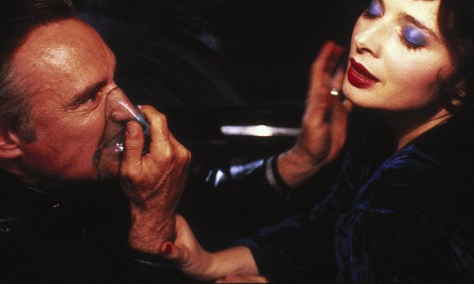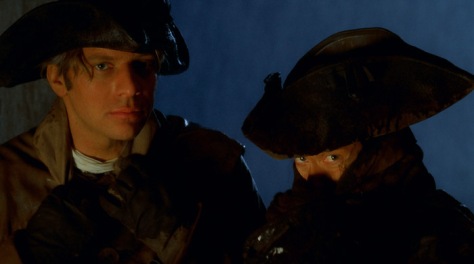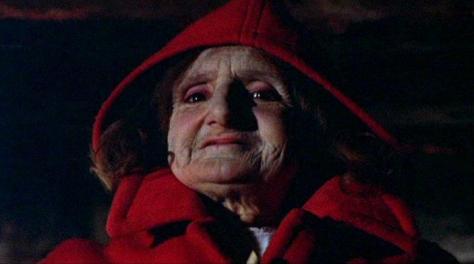By Dennis Hartley
(Originally posted on Digby’s Hullabaloo on October 14, 2017)

Empathy, evidently, existed only within the human community, whereas intelligence to some degree could be found in every phylum and order including the arachnida.
—from Do Androids Dream of Electric Sheep? by Philip K. Dick
What truly defines “being human”? Philosopher Jean-Paul Sartre wrote that “existence precedes and rules essence”. One must assume that he was talking about human beings, because after all, he was one, offering his (“its”?) definition as to what “being human” is.
Which begs this question: what sparks “existence”? To which people usually answer some “thing” or some “one”. I opened my 2015 review of Neill Blomkamp’s Chappie with this quote from mathematician and cryptologist I.J. Good (an associate of Alan Turing):
Let an ultra-intelligent machine be defined as a machine that can far surpass all the intellectual activities of any man…however clever. Since the design of machines is one of these intellectual activities, an ultra-intelligent machine could design even better machines; there would then unquestionably be an ‘intelligence explosion’, and the intelligence of man would be left far behind. Thus, the first ultra-intelligent machine is the last invention that man need ever make, provided that the machine is docile enough to tell us how to keep it under control.
Such questions and suppositions form the core of Blade Runner, Ridley Scott’s 1982 sci-fi noir about a dystopian near-future where the presence of commercially manufactured “replicants” (near-humans with specialized functions and a built-in 4-year life span) has become routine.
Should there ever be a need to ascertain whether “someone” is a human or a replicant, a procedure called the Voight-Kampf Test is administered. In essence, this series of questions (in conjunction with careful monitoring of autonomic physical responses like heart rate) determines whether or not the subject has empathy for others.
In one scene, “blade runner” Deckard (Harrison Ford), whose job is to hunt down and “retire” aberrant replicants, reluctantly indulges the creator/CEO of the company that manufactures them by giving the test to the CEO’s assistant (a woman Deckard has no reason to suspect as being anything but human).
When “Rachel” (Sean Young) does turn out to be a replicant, the usually unflappable Deckard is agog; once he’s informed “she” (an advanced prototype) is completely unaware she’s not an employee of the company but rather its “product”, he’s perplexed. “How could it not know what it is?” he demands.
In The Philosophy of Neo-Noir (edited by Mark T. Conard), there is an essay with a unique angle on the film by Judith Barad, called “Blade Runner and Sartre”. She writes:
Although the replicants of Blade Runner are engineered to act and reason as humans, they can’t choose their own essence. This inability is, in Sartre’s view, what differentiates any manufactured being from humans. The replicants fulfill a certain function; as members of a series, they didn’t choose their essence. […]
To be human means to create oneself–the emotions one chooses to feel, the beliefs one chooses to retain, and the actions one chooses to perform. […]
In Sartre’s terms, Deckard thinks of replicants as things that exist only to fulfill the essence, the purpose created for them by human beings. At the same time, he is unaware that he has allowed his society to program this belief, a prejudice, into his mind. […]
Blade Runner and Sartre urge us to escape this programming and become authentically human.
If you are a fan of the film, you are likely aware that the two biggest unanswered questions left hanging in 1982 were 1) Was Rachel’s “authentically human” sense of empathy programmed…or was she truly the breakthrough that her “creator” seemed to infer by his cryptic comment that she was “special”? and 2) the biggie I’ve seen people nearly come to blows over: Was Deckard himself a replicant?
Questions…
I imagine the most burning question you have about Denis Villeneuve’s Blade Runner 2049 is: “Are the ‘big’ questions answered?” Don’t ask me. I just do eyes. Which is to say, this is a difficult film to review without risking spoilers, so I am not going into any great detail on plot points (the least I can do for those of you who have made it this far into my “review” and are starting to worry you’ve stumbled into a Philosophy 101 class).
I can assure you that I am not a replicant, because when I heard someone was going to tackle a sequel to an idiosyncratic sci-fi classic with a rabid cult following like Blade Runner, I was fully prepared to have empathy for whoever ended up at the helm. Ridley Scott was originally slated to do it himself, but for whatever reason or circumstance ended up as producer, with Villeneuve directing. I can’t help but speculate that he felt the same pressure that Peter Hyams surely experienced making 2010: The Year We Make Contact.
As implied in the title, the story is set 30 years after the events in the original film. The protagonist is a blade runner named “K” (Ryan Gosling) who, like Deckard, works for the LAPD. Newer-model replicants are more docile (like electric sheep?). However, there are still enough of the older, buggier models lurking out there in the ether to warrant keeping the blade runners on active duty. This is evidenced right out of the gate, as we watch K being left with no choice but to “retire” a truculent gentleman out in the boonies.
When K detects skeletal remains on the recently retired replicant’s property, it sets off an investigation that catches the keen interest of many parties, from K’s commanding officer at the Department (Robin Wright) to the powerful CEO of the monopolistic android-manufacturing Tyrell Corporation (Jared Leto). And yes, one Rick Deckard as well (Harrison Ford). What ensues actually has less in common with the original Blade Runner…as it does with Children of Men, Logan’s Run, and Angel Heart.
Bad news first? The story line is not as deep or complex as the film makers undoubtedly want you to think. The narrative is essentially a 90 minute script (by original Blade Runner co-screenwriter Hampton Fancher and Michael Green), stretched to a 164-minute run time.
However, the “language” of film being two-fold (aural and visual), I must say the visual language of Blade Runner 2049 is mesmerizing. This is due in no small part to the artful eye of cinematographer Roger Deakins (Sid and Nancy, Stormy Monday, Fargo, A Beautiful Mind, Skyfall, et.al), who really knocks it out of the park.
While I alluded to the lengthiness of the film (and you will need to clear some time), I was never bored. In fact, I savored the leisurely pace and immersive visuals; so many sci-fi films these days needlessly assault the eardrums and are so jarringly flash-cut as to induce vertigo (keep in mind that cerebral sci-fi films like Kubrick’s 2001 and Tarkovsky’s Solaris were panned upon initial release as being slow-moving or overlong…like this 1000+ word review).
Gosling delivers another one of his Steve McQueen-ish performances (which some might call deadpan…but it works). In addition to Ford (who has 15 minutes or so of screen time), there is a cameo that should delight fans of the original (and his origami skills have not waned). Leto’s choices are…interesting; they may have better served him as a Bond villain; ditto for his “henchwoman” (played with aplomb by Sylvia Hoeks), recalling Famke Janssen’s “Xenia Onatopp” in Goldeneye. Ana de Armas does the best she can as a holographic companion that feels lifted from Steve De Jarnatt’s 1988 film Cherry 2000.
All in all, Villeneuve has made a sequel that faithfully adheres to the ethos and the physical universe of the original film. It doesn’t necessarily add anything to the original; nor on the other hand does it diminish its “stand-alone” status. You may not find answers to all of those questions I discussed earlier, but you could find yourself still thinking about this film long after the credits roll.
After all, as the acrobatic “Pris” declared in the 1982 film (by way of quoting Descartes), “I think, therefore I am.” Isn’t that what makes us human? OK, that character was a replicant, but that’s beside the point. At least she “lived”, right?
But then again, who does?


















 19 artists go in the cage…only 5 come out.
19 artists go in the cage…only 5 come out.